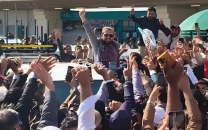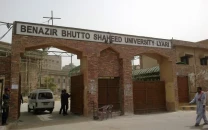Karachi: Politics at the barrel of a gun
Leading parties of Karachi have no incentive to address the deteriorating political, social, and economic conditions.

The Muttahida Qaumi Movement (MQM) and the Awami National Party (ANP) are both attempting to be the last party standing in the metropolis, with the city being ignored by the privileged classes, the negligent state and unconcerned provinces. Ethnically and politically rooted violence, along with an intensifying sectarian conflict, has taken root in the city. Murders occur in broad daylight in endless shootings and bomb attacks. Incidents of kidnapping and extortion finance local violence and fund broader terrorist activity.
The roots of conflict in Karachi lie in the struggle for basic human needs, such as security, distributive justice, and political and economic participation. In this case, feuding groups cleave along ethnic lines creating enduring hostility accompanied by outbreaks of violence. Although defined as political parties, the MQM and the ANP are largely ethnically based. The MQM depends on the Urdu-speaking constituency, whose parents and grandparents migrated from India after Partition to build the Quaid’s vision. In recent years, Pashtuns have made their way to Karachi fleeing conflict in the Afghanistan/Pakistan border areas and seeking economic opportunity. This led to the ANP, a predominantly Pashtun party, rising in Karachi politics with newly gained assembly seats in 2008. In a city with an existing Mohajir majority and a government routinely dominated by the MQM, the large influx of Pashtun migrants disturbed the status quo. With both the MQM and the ANP vying not only for political control of the port city, but also for command over the significant trade conducted here, tensions have escalated to where it is unsafe to enter certain neighbourhoods for fear of being killed due to one’s ethnic appearance.
Politics, violence and criminal activity in Karachi are intertwined. Lethal attacks allegedly authorised by high-ranking officials in political organisations are carried out by hired guns, despite assurances from leaders that their parties follow peaceful processes. Criminal organisations operate with political patronage from local parties. Furthermore, infiltration by the Taliban threatens to exacerbate Karachi’s violence and instability, most recently demonstrated by the attack on Jinnah International Airport. The Pakistan Army recently launched Operation Zarb-e-Azb to counter extremists, but it is limited to North Waziristan, while Karachi remains relatively unprotected by national law enforcement or military forces. Many Taliban operatives fleeing the military offensive are certain to relocate to Karachi for safety and to take advantage of the flourishing criminal activities here. Karachi foreshadows Pakistan’s future if the political leadership treats the spreading terrorist networks as it has the ongoing violence in Karachi: with an incoherent counterterrorism policy, inadequate infrastructure and public services, and an abdication of responsibility towards good governance.
A Crisis Group Asia Report, Policing Urban Violence in Pakistan, found 2,174 killings reported in Karachi in 2012 and over 2,700 in 2013. A report issued by the Human Rights Commission of Pakistan puts the number of violent deaths in Karachi in 2013 at 3,200. Yet, the neglect shown towards this key city by the national leadership suggests not only a lack of concern for its denizens but also for its significant economic value. A city of 20 million and the largest in Pakistan, Karachi dominates the domestic economy as well as provides the bulk of the country’s GDP. Despite this, Nawaz Sharif’s government has done little to quell violence in the city except to establish a committee to monitor law enforcement, all while Karachi’s inhabitants and economy suffer as collateral damage. Not only are the police and civil administration powerless against the strength of armed, established gangs with significant political and financial backing, many are part of the collusion that allows criminal organisations and militant groups to operate without consequence. Legal measures were implemented in September 2013 to empower Pakistan’s paramilitary force the Rangers for extended operations in the city when the police were deemed incapable of maintaining law and order and an army mandate considered too severe and potentially destabilising. But even paramilitary efforts proved to be temporary and failed to curb violence. They are reminiscent of a similar Rangers-led operation conducted in 2011 at the order of then president Asif Ali Zardari, a clearly unsuccessful initiative considering persisting urban violence.
State initiatives to respond to Karachi’s volatile conditions are superficial and ad hoc, and continually refuse to acknowledge the root causes of the city’s upheaval — deficient urban development, political and societal fragmentation, corruption of the police, ineffective criminal justice procedures and lack of ethical governance. These systemic issues are at the core of multifaceted ethno-political, sectarian, militant and criminal violence in Karachi. As manifestations of political and ethnic power grabs, targeted killings are part of a larger phenomenon of political tensions and violent conflict in Pakistan that is being carelessly overlooked or systematically ignored. The leading parties of Karachi have no incentive to address the deteriorating political, social, and economic conditions because investing in violent efforts to control the whole city yields larger direct gains than a collaborative agreement that promotes democratic participation and distributes resources more broadly. The party ruling at the centre, the PML-N, with its Punjab-centric view, seems untroubled by the unrelenting violence. A high-level meeting between Prime Minister Sharif, former president Zardari, and the Director General of Inter-Services Intelligence discusses law enforcement in the city while the ground reality hardly changes and Karachi still waits for an end to its suffering.
Published in The Express Tribune, July 15th, 2014.
Like Opinion & Editorial on Facebook, follow @ETOpEd on Twitter to receive all updates on all our daily pieces.



















COMMENTS
Comments are moderated and generally will be posted if they are on-topic and not abusive.
For more information, please see our Comments FAQ